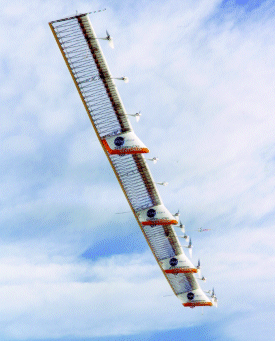
Guy Norris/LOS ANGELES
THE Centurion, a 63m (206ft) span flying wing, has completed initial low-altitude flight tests at NASA's Dryden Flight Research Center at Edwards AFB, California.
The aircraft has since been disassembled and returned to its designer and manufacturer, AeroVironment of Simi Valley, California.
There several of its systems will be upgraded to handle the extreme low temperatures of higher altitudes in the 90,000-100,000ft (27,500-30,500m) range where it will be flown in a future test phase.
The Centurion is being tested as part of NASA's Environmental Research Aircraft and Sensor Technology (ERAST) programme, which is developing technology for future remotely piloted, long duration, high altitude science and telecommunications platforms.
Centurion, which has 14 electrically powered propellers, is designed for sustained flight at up to 100,000ft using solar power. Initial low-altitude tests have used battery power for the engines, but the higher altitude tests, scheduled to take place between 1999 and 2001, will involve a rechargeable fuel cell-based energy storage system.
This will provide the basis for Helios, a 76m-span vehicle that AeroVironment says could fly continuously for months on science or telecommunications missions. The aircraft would be covered with solar cells, as will the upgraded Centurion, which will soak up and store energy during the day to keep the motors operating at night.
The Centurion's initial test phase was completed after the third flight over Rogers Dry Lake, adjacent to Dryden, on 3 December. The mission, the culmination of tests that began on 10 November, included carrying a simulated payload of 270kg (600lb), virtually half of the Centurion's empty weight.
The NASA team says the fragile-looking craft "performed exactly as expected" with the heavier load, which was carried to a maximum altitude of 400ft.
Source: Flight International























